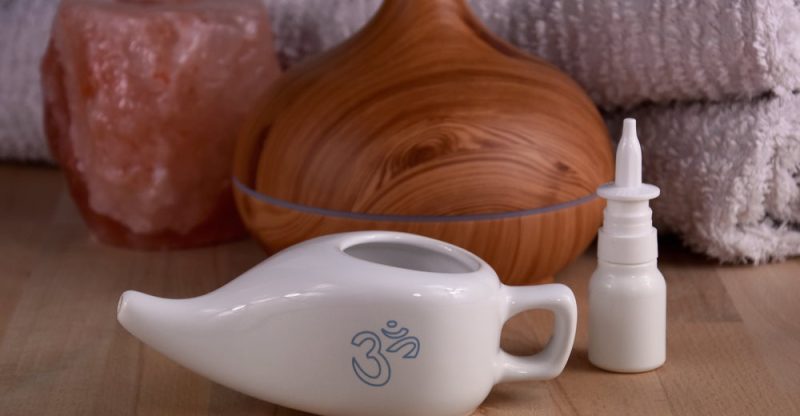Neti Pot 101 – Benefits, Uses
The Neti Pot has been used for centuries to cleanse nasal passages. It is common in Hindu and Buddhist cultures and those of other Eastern religions like Taoism and Jainism. The benefits are many, with some claiming it can reduce allergies or even help prevent sinusitis!
Nasal irrigation is done using a neti pot. Irrigation of the nose? It may seem unusual, but nasal flushing is merely the process of clearing your nasal cavity. A neti pot enables a user to accomplish precisely that using a solution of purified water and salt rapidly and efficiently. Yes, there are just two basic components. A neti pot may be precisely what the doctor ordered if mucus or allergies are clogging up and aggravating your nose. Many physicians advocate using a neti pot for general nasal congestion, colds, allergies, and sinus infections, among other things.
According to a study of 330 active practicing family physicians, 87 percent recommended saline nasal irrigation (which is what you do with a neti pot) as part of their treatment recommendations for the following health issues: chronic sinus infections (91 percent), acute bacterial sinus infections (67 percent), rhinitis (stuffy nose) caused by seasonal allergies (66 percent), viral upper respiratory infections (59 percent), another allergic rhinitis (48 percent), and rhinitis caused by other allergies (17 percent).
Many neti pot users report improved senses of smell and taste following a neti pot session and easier breathing through their nostrils. According to FDA physicians, neti pots are generally safe as long as they are used and cleaned correctly. You can easily get a neti pot at your local pharmacy store or health food shop these days without breaking the bank (excellent ones can be found for around $10). If you haven’t already, you may want to get one after reading this post. I’ll also demonstrate how simple and inexpensive it is to produce your own neti pot solution at home.
What Is a Neti Pot?
A neti pot is a device that uses steam to clean and rejuvenate the nasal passages. Neti pots are little teapot-like containers made of plastic or ceramic. Ayurvedic medicine gave birth to the neti pot. “Neti” means “nasal washing” in Sanskrit.
What are neti pots, and how do they work? A neti pot allows the user to pour a nasal rinse into the nostrils, flushing away irritants and thinning mucus. This usually results in reduced congestion and better nasal breathing. In addition, a neti pot helps your body’s natural functions by acting as a booster. What exactly do I mean? Cilia are microscopic hair-like structures that border the nasal canal and adjacent sinuses. Cilia aid in the removal of mucus from the nose. Nasal irrigation with a saline solution is supposed to assist the cilia in removing mucus and undesirable particles (such as dust, pollen, and other allergens) that may cause sinus problems.
A neti pot comprises purified water and salt or salt-based combination created particularly for neti pot usage. Make your own neti pot solution at home (recipe coming later in this article). You may be wondering why water alone isn’t allowed in your neti pot. It’s an amazing truth that just utilizing water may irritate the insides of your nostrils. When you add salt to purified water, it allows the water to glide past the delicate membranes of the nasal passages with little to no burning.
6 Health Advantages
1. Clogged Sinuses
For ages in India, flushing warm salty water through the nasal canals has been utilized to relieve nasal congestion and allergies. Sinus congestion may be caused by environmental irritants such as dust, pollen, chemicals, or synthetic scents. A neti pot is a fantastic instrument for doing nasal irrigation and reducing sinus congestion in general. Whatever the reason, neti pots are best known for washing out any unwelcome intruders and extra mucus from the inside of your nose, making it healthier and less irritating.
2. Colds
Nasal congestion is one of the most prevalent side effects of the common cold. It’s also possible that a sinus headache and facial discomfort accompany it. When you use a neti pot for a stuffy nose caused by a cold, the mucus thins out and freely drains. This may assist with a variety of cold symptoms. It will help if you drink plenty of water and use a neti pot to help break up mucus.
3. Infections of the Sinuses
A neti pot may not only aid with an acute sinus infection, but it can also help with chronic sinusitis. According to research published in the Canadian Medical Association Journal, patients with persistent sinus infections could alleviate their symptoms and sustain favorable results for six months. The research participants were not simply relieved of nasal congestion. They also had fewer headaches and needed to use fewer over-the-counter medications. Higher volume neti pots absolutely top nasal sprays, according to Dr. Richard J. Harvey, a professor of rhinology at Macquarie University. This is because the neti pot performs genuine nasal irrigation, eliminating both irritants and extra mucus.
4. Allergies
If you’re one of the millions of individuals who suffer from allergies regularly, it’s good to break out your neti pot when allergy season arrives. Nasal congestion and post-nasal drip are two frequent allergy symptoms. “Nasal irrigation is one of the greatest treatments for easing the symptoms,” says Melissa Pynnonen, M.D., co-director of the Michigan Sinus Center. It’s like scrubbing your nose with a pressure washer.” Nasal irrigation using a neti pot is even believed to be more effective than popular sinus treatments. It is considered “the first-line therapy for common nose and sinus problems” by many clinicians, including Dr. Pynnonen.
Nasal irrigation with a saline solution is not only a safe and economical technique to alleviate a stuffy nose caused by allergies, according to a 2010 scientific study published in the American Journal of Rhinology and Allergy. It also improves the allergy sufferer’s general quality of life and reduces the need for allergy drugs.
5. Sinus Problems Associated with Pregnancy
Pregnancy may cause a lot more than just food cravings and weariness for some women. Some pregnant women have nasal congestion as a result of hormonal changes. Pregnancy specialists often recommend Nasal irrigation, such as the American Pregnancy Association and the Mayo Clinic, as a safe and efficient home treatment for moms-to-be to relieve general congestion and congestion caused by sinus infections and allergies.
6. Snoring
If your snoring is caused by sinus congestion, a neti pot might help you clear your nose. You’ll probably be able to stop snoring after you’ve gotten rid of the congestion. A neti pot might be the key to snore-free sleep for some people.
Homemade Neti Pot Recipe
In your neti pot, you must utilize a suggested and safe water source. According to the FDA, there are only two types of water that may be used in a neti pot:
- You can buy distilled or sterile water in shops (the labels will say “distilled” or “sterile”).
- Before using, use tap water that has been heated for at least three to five minutes and then cooled to lukewarm.
- Previously boiled water may be kept for up to 24 hours in a clean, closed container.
- Water that has passed through a filter intended to capture potentially infectious organisms. A filter with an absolute pore size of 1 micron or less, or a label that says “NSF 53” or “NSF 58,” according to the CDC, is recommended.
You may purchase a pre-made sinus rinse to use as a solution. You may also prepare your own neti pot solution at home. Blend a quarter teaspoon to a half teaspoon of non-iodized salt with one cup of filtered (see list above) water. If desired, a pinch of baking soda may also be added. Double the quantity of salt and baking soda if you’re using two cups of water.
You mustn’t use a salt that includes any other components in your neti pot. The salt you use to prepare a DIY neti pot solution should only include one ingredient: salt. This is because the salt-to-water equilibrium of your body’s tissues is claimed to be mimicked by a healthy solution. You may use sea salt, kosher salt, or simple cooking salt for your solution.
You’re ready to use your neti pot after you’ve put your nasal rinse solution in it and cleansed and dried your hands.
The following are instructions on how to use a neti pot:
1. Lean forward and lean your head sideways over a sink (about a 45-degree angle). Place the spout of the neti pot in the upper nostril (the one closer to the ceiling)
2. Slowly pour the contents of the neti pot into that upper nostril while breathing through your open mouth. The neti pot solution will almost instantly flow out of the lower nostril. It’s a good thing since nasal irrigation has finally started!
3. Do the same thing on the opposite side. In each nostril, use roughly half of the neti pot’s contents.
The whole procedure takes less than 5 minutes, so it is not a significant time commitment. When it comes to messiness, you’ll want to be leaning over a sink since fluids will be dripping from your nose. You’ll probably not get your clothing wet after some practice. You may have a few wet spots once you’ve finished at first. They’ll dry fast and won’t stain, so don’t worry.
Common Mistakes and Risks
When it comes to neti pots, the most serious issue is employing a potentially hazardous water source. I mean bacteria-infested water when I say hazardous. This may happen if you don’t boil and cold your tap water before using it in your neti pot. Always utilize the approved water sources and never take any risks. If you use bacteria-infected water in your neti pot, you might die. In the United States in 2011, at least two people died due to incorrect neti pot usage. Both fatalities were caused by drinking tap water tainted with Naegleria fowleri, a very deadly germ.
Primary amebic meningoencephalitis is caused by the bacteria Naegleria fowleri (PAM). PAM symptoms generally appear 1 to 9 days after infection. Headache, fever, nausea, and vomiting are common early symptoms. Stiff neck, disorientation, lack of attention to people and surroundings, loss of balance, seizures, and hallucinations are some of the latter stage symptoms. The illness progresses quickly and usually results in death within 5 days after start. Not to scare you, but there is an excellent and terrifying reason you should never meddle with the water in your neti pot.
In addition to using filtered water, it’s critical to maintain your neti pot as clean as possible. To avoid germs, clean it carefully every time you use it with the same high-quality water that you used in it. It’s also good to let your neti pot air dry fully between usage or dry it well with paper towels. You may run your neti pot in the dishwasher once in a while if it’s dishwasher safe. Finally, wash and dry your hands before using your neti pot to avoid spreading germs.
Neti pots and toothbrushes are similar in that they should never be shared. Of course, sharing a neti pot with your family members would be more cost-efficient. However, it is not a safe or hygienic practice.
Another typical blunder with neti pots is to use them excessively. Like with many natural therapies, overdoing it does not result in better outcomes but rather causes additional issues. Short-term nasal irrigation may be beneficial and therapeutic, according to 2009 research, while long-term usage can be hazardous. It’s thought that using a neti pot too often might destroy part of the mucus membranes that border the nasal passages and sinuses’ key protective features. That is obviously not what you want, so don’t use your neti pot excessively.
Neti pots are not recommended for children under the age of two. If you suffer any pain or unfavorable side effects after using a neti pot, stop using it immediately and seek medical help.
Last Thoughts
Amazingly, a little teapot-like dish and some salty water can provide such quick and simple nasal congestion relief. It’s not difficult to use a neti pot, and it’s not costly. It’s not even supposed to be done often.
Even traditional medicine agrees with holistic and Ayurvedic medicine practitioners when applied correctly. Allergies, the common cold, sinus infections, and pregnancy are all great reasons to use a neti pot to relieve nasal congestion. Scientific evidence also exists to support this century-old nose irrigation technique. Remember to use the appropriate salt (no additions!) in a well-cleaned neti pot with safe, filtered water.
Get your neti pot out if you’re suffering from nasal congestion. You’ll probably be breathing a lot (or at least a little) easier in less than five minutes!
Frequently Asked Questions
What are the health benefits of using a neti pot?
A: It is used to flush water and salt into one’s nose. The saline solution helps with sinus health, while the irrigation of your nasal cavity helps clear out any mucous buildup that might contribute to a stuffy head or headaches. Neti pots are also helpful for people who have problems keeping their eyes open during sleep due to having too much pressure on their faces and those experiencing migraines.
Does nasal irrigation help with congestion?
A: Yes, nasal irrigation can help with congestion.
Why shouldn’t you use a neti pot?
A: Neti pots are not recommended because saltwater can cause a lot of damage to your sinuses.
FDA Compliance
The information on this website has not been evaluated by the Food & Drug Administration or any other medical body. We do not aim to diagnose, treat, cure or prevent any illness or disease. Information is shared for educational purposes only. You must consult your doctor before acting on any content on this website, especially if you are pregnant, nursing, taking medication, or have a medical condition.
HOW WOULD YOU RATE THIS ARTICLE?





